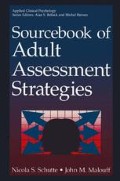Abstract
This scale measures the characteristic impulsiveness of individuals. The latest version of the Barratt Impulsiveness Scale is a 30-item self-report meassure (Patton, Stanford, & Barratt, in press). Barratt developed the first version of the scale in 1959 (Barratt, 1959) and then revised and refined the scale over the years (Barratt, 1985; Barratt, 1993). The eleventh and latest version was created by eliminating from the previous version of the scale those items that did not contribute to the reliability or validity of the scale. Patton et al. (in press) factor analyzed the responses of undergraduate students, psychiatric inpatients, and prisoners in a maximum security facility and found three main second-order factors. These factors were motor impulsiveness, nonplanning impulsiveness, and attentional impulsiveness.
Access this chapter
Tax calculation will be finalised at checkout
Purchases are for personal use only
Preview
Unable to display preview. Download preview PDF.
References
Barratt, E. S. (1959). Anxiety and impulsiveness related to psychomotor efficiency. Perceptual and Motor Skills, 9, 191–198.
Barratt, E. S. (1985). Impulsiveness subtraits: Arousal and information processing. In J. T. Spence and C. E. Izard (Eds.), Motivation, Emotion, and Personality (pp. 137–146). North Holland: Elsevier Science Publishers.
Barratt, E. S. (1993). Impulsivity: Integrating cognitive, behavioral, biological, and environmental data. In W. B. McCown, J. L. Johnson and M. B. Shure (Eds.), The Impulsive Client: Theory, Research, and Treatment (pp. 39–56). Washington, DC: American Psychological Association.
Campbell, J. B. (1987). Measures of impulsivity. Personality and Individual Differences, 8, 451.
Carrillo-de-la-Pena, M. T., Otero, J. M., & Romero, E. (1993). Comparison among various methods of assessment of impulsiveness. Perceptual and Motor Skills, 77, 567–575.
Lesieur, H.R., & Blume, S. B. (1987). The South Oaks Gambling Screen (The SOGS): A new instrument for the identification of pathological gamblers. American Journal of Psychiatry, 144, 1184–1188.
Lesieur, H. R., & Blume, S. B. (1993). Revising the South Oaks Gambling Screen in different settings. Journal of Gambling Studies, 9, 213–223.
Lesieur, H. R., Cross, J., Frank, M., Welch, M., White, C. M., Rubenstein, G., Mosley, K., & Mark, M. (1991). Gambling and pathological gambling among university students. Addictive Behavior: An International Journal, 16, 517–527.
Luengo, M. A., Carrillo-de-la-Pena, M. T., & Otero, J. M. (1991). The components of impulsiveness: A comparison of the 1.7 Impulsiveness Questionnaire and the Barratt Impulsiveness Scale. Personality and Individual Differences, 12, 657–667.
Patton, J H., Stanford, M. S., & Barratt, E. S. (in press). Factor Structure of the Barratt Impulsiveness Scale. Journal of Clinical Psychology.
Royse, D., & Wiehe, V. R. (1988). Impulsivity in felons and unwed mothers. Psychological Reports, 62, 335–336.
Templer, D. I., Kaiser, G., & Siscoe, K. (1993). Correlates of pathological gambling propensity in prison inmates. Comprehensive Psychiatry, 34, 347–351.
Volberg, R. A., & Banks, S. M. (1990). A review of two measures of pathological gambling in the United States. Journal of Gambling Studies, 6, 153–163.
Volberg, R. A., & Steadman, H. (1988). Refining prevalence estimates of pathological gambling. American Journal of Psychiatry, 145, 502–505.
Volberg, R. A., & Steadman, H. (1989). Prevalence estimates of pathological gambling in New Jersey and Maryland. American Journal of Psychiatry, 146, 1618–1619.
Author information
Authors and Affiliations
Rights and permissions
Copyright information
© 1995 Springer Science+Business Media New York
About this chapter
Cite this chapter
Schutte, N.S., Malouff, J.M. (1995). Impulse-Control Disorders. In: Sourcebook of Adult Assessment Strategies. Applied Clinical Psychology. Springer, Boston, MA. https://doi.org/10.1007/978-1-4899-1277-0_12
Download citation
DOI: https://doi.org/10.1007/978-1-4899-1277-0_12
Publisher Name: Springer, Boston, MA
Print ISBN: 978-1-4899-1279-4
Online ISBN: 978-1-4899-1277-0
eBook Packages: Springer Book Archive

